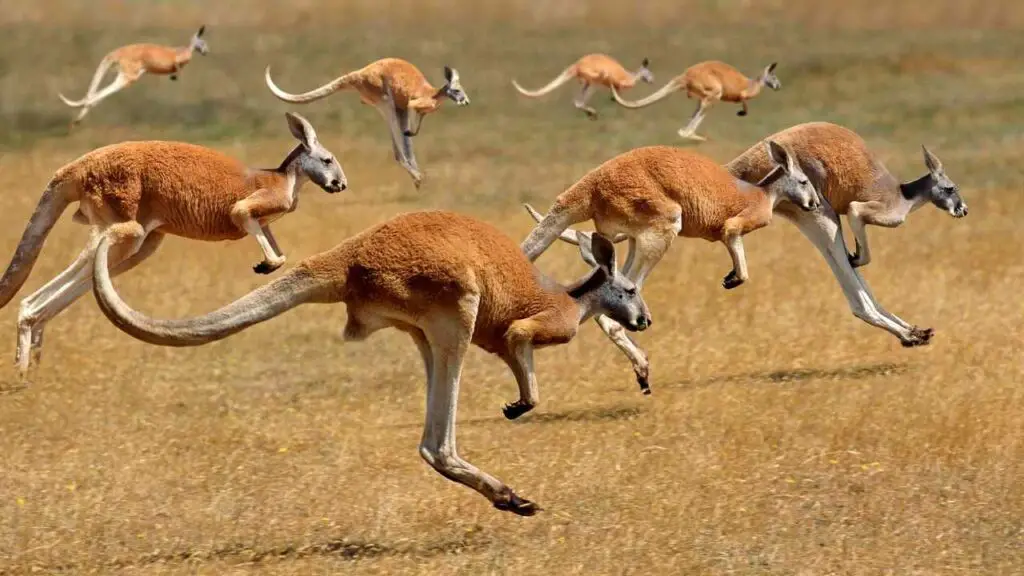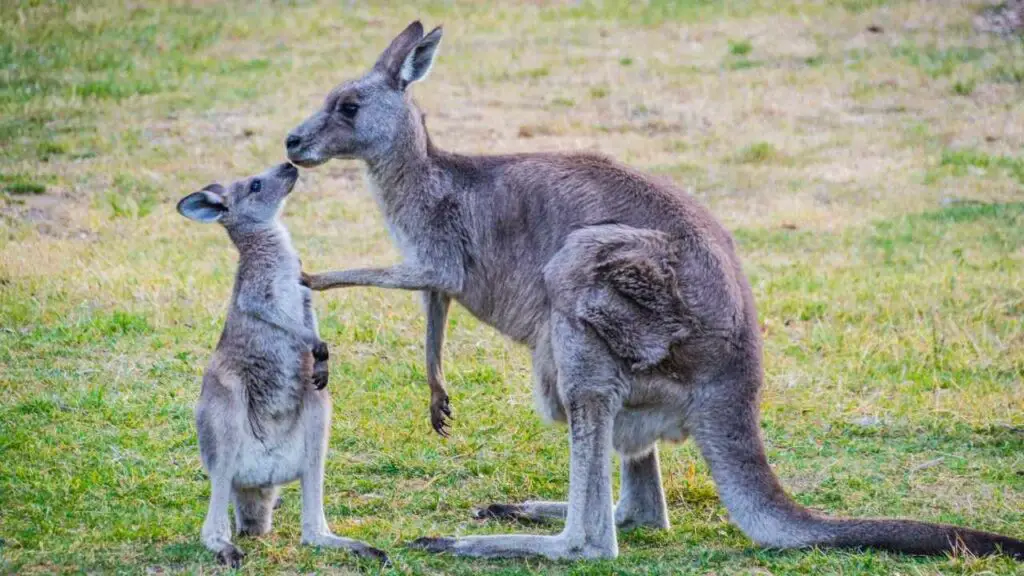Kangaroos are special mammals from Australia. They are characterized by their powerful hind legs, large feet adapted for leaping, long muscular tail for balance, and a distinctive pouch in females where they carry and nurse their young, known as joeys.
Adaptations of a Kangaroo
Kangaroos have evolved adaptations that enable them to thrive in the Australian environment. Here are some key adaptations:
- Hopping: Kangaroos move by hopping, which helps them cover long distances quickly while conserving energy.
- Tail: Their long, strong tails help them balance while hopping and support their weight when standing or sitting.
- Diet: They eat grass and plants, and their digestive system is specialized to get the most nutrition from these foods.
- Staying Cool: In hot weather, kangaroos cool down by licking their forearms, and in cold weather, they can generate heat by increasing their metabolism.
- Reproduction: Female kangaroos have pouches where they carry and nurse their young until they’re ready to venture out.
- Social Life: Kangaroos often live in groups called mobs, where they have social structures that help them find food, stay safe, and raise their young.
These adaptations collectively enable kangaroos to thrive in Australia’s diverse and challenging environments, making them iconic symbols of the continent’s unique wildlife.
Behavioral Adaptations of Kangaroos
Kangaroos have several behavioral adaptations that help them survive and thrive:
Mob Living:
Kangaroos often live in groups called mobs. Living in groups helps them find food, protect themselves from predators, and raise their young more effectively.
Hierarchical Structure:
Within mobs, kangaroos establish hierarchies, with dominant individuals prioritizing access to resources such as food and mates.
Foraging Behavior:
Kangaroos are primarily herbivores, grazing on grasses and vegetation, they have adapted feeding behaviors to efficiently extract nutrients from their diet.
Water Conservation:
Kangaroos have adapted to arid environments by efficiently using water. They can obtain much of their moisture from the plants they eat and are known to conserve water by reducing urine production during dry periods.
Thermoregulation:
Kangaroos have behavioral strategies to regulate their body temperature. In hot weather, they seek shade or cooling resting spots, and they may lick their forearms to facilitate evaporative cooling. In colder weather, they huddle together to conserve body heat. Additionally, kangaroos are primarily crepuscular and nocturnal, meaning they are most active during the cooler parts of the day, such as dawn, dusk, and nighttime. This behavioral pattern serves as a thermoregulatory adaptation, allowing them to avoid the heat of the day while maximizing their activity during more temperate periods.
Communication:
Kangaroos use various vocalizations, body postures, and movements to communicate with one another. These signals help coordinate group activities, warn of potential threats, and establish social bonds within the mob. Additionally, kangaroos can produce a distinctive thumping sound with their feet, serving as a warning to them of impending danger. Furthermore, they possess the remarkable ability to swiftly leap into water bodies as a means of escaping predators, demonstrating another facet of their communication repertoire adapted for survival.
These behavioral adaptations allow kangaroos to move around effectively, find food and water, stay safe from predators, and stick together in their groups.
Structural Adaptations of Kangaroo
Kangaroos possess several structural adaptations that enable them to thrive in their natural environment:
Powerful Hind Legs:
Kangaroos have powerful large, muscular hind legs designed for hopping, their primary mode of locomotion. This adoption allows them to cover large distances quickly and efficiently.
Long tail:
Kangaroos have a long, muscular tail that serves as a stabilizer while hopping. It also helps them balance when moving at high speeds and acts as a prop when they are stationary.
Specialized Feet:
These feet are adapted for hopping, with strong, elastic tendons that store and release energy with each bound. The hind feet are large and have elongated toes, while the forelimbs are small and primarily used for grooming and balance.
Flexible Spine:
Their flexible spine helps them absorb the impact of landing when they hop and lets them move easily in different environments.
Claws:
Kangaroos have strong front arms and claws for grooming, digging, and sometimes defense.
Pouch:
Female kangaroos have a pouch where they carry and nurse their babies until they’re ready to come out.
Color:
The coloration of kangaroos’ fur provides effective camouflage, blending seamlessly into their surroundings and offering protection against predators.
Physiological Adaptations of Kangaroo
Kangaroos have several physiological adaptations that help them survive and thrive in their environment:
Efficient Digestive System:
Kangaroos have a specialized stomach with multiple chambers, similar to other ruminants like cows. This allows them to efficiently digest tough, fibrous plant material.
Water Conservation:
Kangaroos have adapted to conserve water in their bodies, enabling them to survive in arid environments where water is scarce. They produce highly concentrated urine and have efficient kidneys to minimize water loss.
Thermoregulation:
Kangaroos regulate their body temperature through various mechanisms. They lick their forearms, which have extensive blood vessels, to cool down through evaporation. Additionally, they rest during the hottest parts of the day to conserve energy and reduce heat stress.
Delayed Reproduction:
Female kangaroos can delay the development of their embryos during periods of drought or food scarcity. This adaptation, known as embryonic diapause, allows them to conserve energy and resources until conditions improve.
Highly Developed Senses:
Kangaroos have a keen sense of hearing, smell, and vision, allowing them to detect predators and locate food sources their large, mobile ears can rotate independently to pinpoint sounds, while their eyes are positioned on the sides of their head, providing a wide field of view.
Salt Tolerance:
In regions where salt is abundant, such as coastal areas, kangaroos have adapted to tolerate high levels of salt in their diet, they have specialized glands in their kidneys to excrete excess salt from their bodies.






Leave a Reply